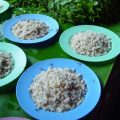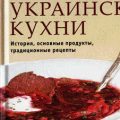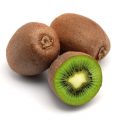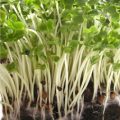Green Inspiration
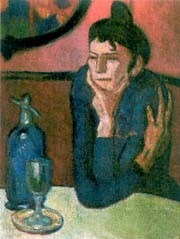 Absinthe recipeThe word "absinthe" promisesmuch - a sense of a changed, magically transformed reality, an adventure like those experienced by Picasso, Toulouse-Lautrec, Verlaine, Rimbaud, Van Gogh. They knew that absinthe - a one-way ticket to a country from which you don't want to return. It is no longer possible to go crazy from the present one. That "green fairy" that reaped her harvest in cafes occupied by Parisian bohemians has long been outlawed, exposed by Aesculapius and neutralized. The absinthe that Maupassant, Verlaine, Rimbaud, Baudelaire, Edgar Allan Poe, Wilde, Remarque, Apollinaire, Thackeray, O. Henry and thousands of Frenchmen got drunk on at the end of the 19th - beginning of the 20th century no longer exists. It remained only on the great canvases of the impressionists - an emerald bottle, a half-empty glass in which the dull eyes of absinthe lovers are reflected. There were many of them, these voluntary victims of their own hallucinations. History has preserved the nameless "Absinthe Drinker" painted by Edouard Manet, the drunkards from the canvas "Absinthe" by Edgar Degas. Picasso added to this gallery his "Absinthe Drinker", who burns out at a cafe table, sharing her loneliness with a green bottle, and "Wandering Acrobats" with the deathly stamp of absintheism on their faces. Van Gogh, the most famous victim of absinthe, is depicted in a painting by Toulouse-Lautrec hugging a glass of green liqueur. Vincent van Gogh also left his own still life - a table, a decanter of absinthe and a glass, which brings him one step closer to madness and a tragic ending. They say that the artist owes his famous color palette to absinthe poisoning - first the green fairy gave him the world in yellow light, and then overturned it into black. The wormwood elixir, which became the curse of Parisian bohemia, was invented by the French doctor Pierre Ordinaire, who fled from the Great Revolution to Switzerland. He found wild wormwood in the village of Couvet and began experiments. It was a time of great accidental discoveries. In 1792, the fairy appeared from the retort - A 70-degree alcohol tincture containing extracts of wormwood, anise, hyssop, fennel, lemon balm, coriander, speedwell, chamomile, parsley and spinach. The doctor prescribed it for all ailments - what could be a better remedy for problems than complete oblivion. Patients quickly became addicted to the medicine and began to increase the doses. A few years later, the recipe went to Henri-Louis Pernod, who opened the first enterprise in Switzerland for the production and sale of absinthe. At the same time, another version of the tincture was invented, with anise in the leading role - later the world would learn about it under the name of Pernod. To give absinthe a special charm, they began to color it with chlorophyll - a real green snake was born. Absinthe.
Absinthe recipeThe word "absinthe" promisesmuch - a sense of a changed, magically transformed reality, an adventure like those experienced by Picasso, Toulouse-Lautrec, Verlaine, Rimbaud, Van Gogh. They knew that absinthe - a one-way ticket to a country from which you don't want to return. It is no longer possible to go crazy from the present one. That "green fairy" that reaped her harvest in cafes occupied by Parisian bohemians has long been outlawed, exposed by Aesculapius and neutralized. The absinthe that Maupassant, Verlaine, Rimbaud, Baudelaire, Edgar Allan Poe, Wilde, Remarque, Apollinaire, Thackeray, O. Henry and thousands of Frenchmen got drunk on at the end of the 19th - beginning of the 20th century no longer exists. It remained only on the great canvases of the impressionists - an emerald bottle, a half-empty glass in which the dull eyes of absinthe lovers are reflected. There were many of them, these voluntary victims of their own hallucinations. History has preserved the nameless "Absinthe Drinker" painted by Edouard Manet, the drunkards from the canvas "Absinthe" by Edgar Degas. Picasso added to this gallery his "Absinthe Drinker", who burns out at a cafe table, sharing her loneliness with a green bottle, and "Wandering Acrobats" with the deathly stamp of absintheism on their faces. Van Gogh, the most famous victim of absinthe, is depicted in a painting by Toulouse-Lautrec hugging a glass of green liqueur. Vincent van Gogh also left his own still life - a table, a decanter of absinthe and a glass, which brings him one step closer to madness and a tragic ending. They say that the artist owes his famous color palette to absinthe poisoning - first the green fairy gave him the world in yellow light, and then overturned it into black. The wormwood elixir, which became the curse of Parisian bohemia, was invented by the French doctor Pierre Ordinaire, who fled from the Great Revolution to Switzerland. He found wild wormwood in the village of Couvet and began experiments. It was a time of great accidental discoveries. In 1792, the fairy appeared from the retort - A 70-degree alcohol tincture containing extracts of wormwood, anise, hyssop, fennel, lemon balm, coriander, speedwell, chamomile, parsley and spinach. The doctor prescribed it for all ailments - what could be a better remedy for problems than complete oblivion. Patients quickly became addicted to the medicine and began to increase the doses. A few years later, the recipe went to Henri-Louis Pernod, who opened the first enterprise in Switzerland for the production and sale of absinthe. At the same time, another version of the tincture was invented, with anise in the leading role - later the world would learn about it under the name of Pernod. To give absinthe a special charm, they began to color it with chlorophyll - a real green snake was born. Absinthe.





